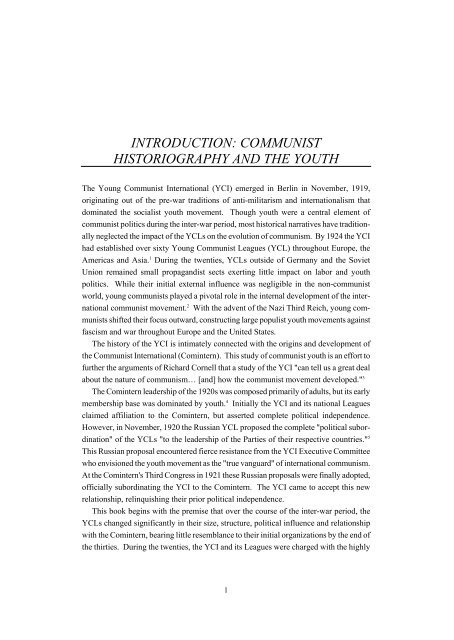Joel A Lewis Youth Against Fascism.pdf
Joel A Lewis Youth Against Fascism.pdf
Joel A Lewis Youth Against Fascism.pdf
Create successful ePaper yourself
Turn your PDF publications into a flip-book with our unique Google optimized e-Paper software.
INTRODUCTION: COMMUNIST<br />
HISTORIOGRAPHY AND THE YOUTH<br />
The Young Communist International (YCI) emerged in Berlin in November, 1919,<br />
originating out of the pre-war traditions of anti-militarism and internationalism that<br />
dominated the socialist youth movement. Though youth were a central element of<br />
communist politics during the inter-war period, most historical narratives have traditionally<br />
neglected the impact of the YCLs on the evolution of communism. By 1924 the YCI<br />
had established over sixty Young Communist Leagues (YCL) throughout Europe, the<br />
Americas and Asia. 1 During the twenties, YCLs outside of Germany and the Soviet<br />
Union remained small propagandist sects exerting little impact on labor and youth<br />
politics. While their initial external influence was negligible in the non-communist<br />
world, young communists played a pivotal role in the internal development of the international<br />
communist movement. 2 With the advent of the Nazi Third Reich, young communists<br />
shifted their focus outward, constructing large populist youth movements against<br />
fascism and war throughout Europe and the United States.<br />
The history of the YCI is intimately connected with the origins and development of<br />
the Communist International (Comintern). This study of communist youth is an effort to<br />
further the arguments of Richard Cornell that a study of the YCI "can tell us a great deal<br />
about the nature of communism… [and] how the communist movement developed." 3<br />
The Comintern leadership of the 1920s was composed primarily of adults, but its early<br />
membership base was dominated by youth. 4 Initially the YCI and its national Leagues<br />
claimed affiliation to the Comintern, but asserted complete political independence.<br />
However, in November, 1920 the Russian YCL proposed the complete "political subordination"<br />
of the YCLs "to the leadership of the Parties of their respective countries." 5<br />
This Russian proposal encountered fierce resistance from the YCI Executive Committee<br />
who envisioned the youth movement as the "true vanguard" of international communism.<br />
At the Comintern's Third Congress in 1921 these Russian proposals were finally adopted,<br />
officially subordinating the YCI to the Comintern. The YCI came to accept this new<br />
relationship, relinquishing their prior political independence.<br />
This book begins with the premise that over the course of the inter-war period, the<br />
YCLs changed significantly in their size, structure, political influence and relationship<br />
with the Comintern, bearing little resemblance to their initial organizations by the end of<br />
the thirties. During the twenties, the YCI and its Leagues were charged with the highly<br />
1

















